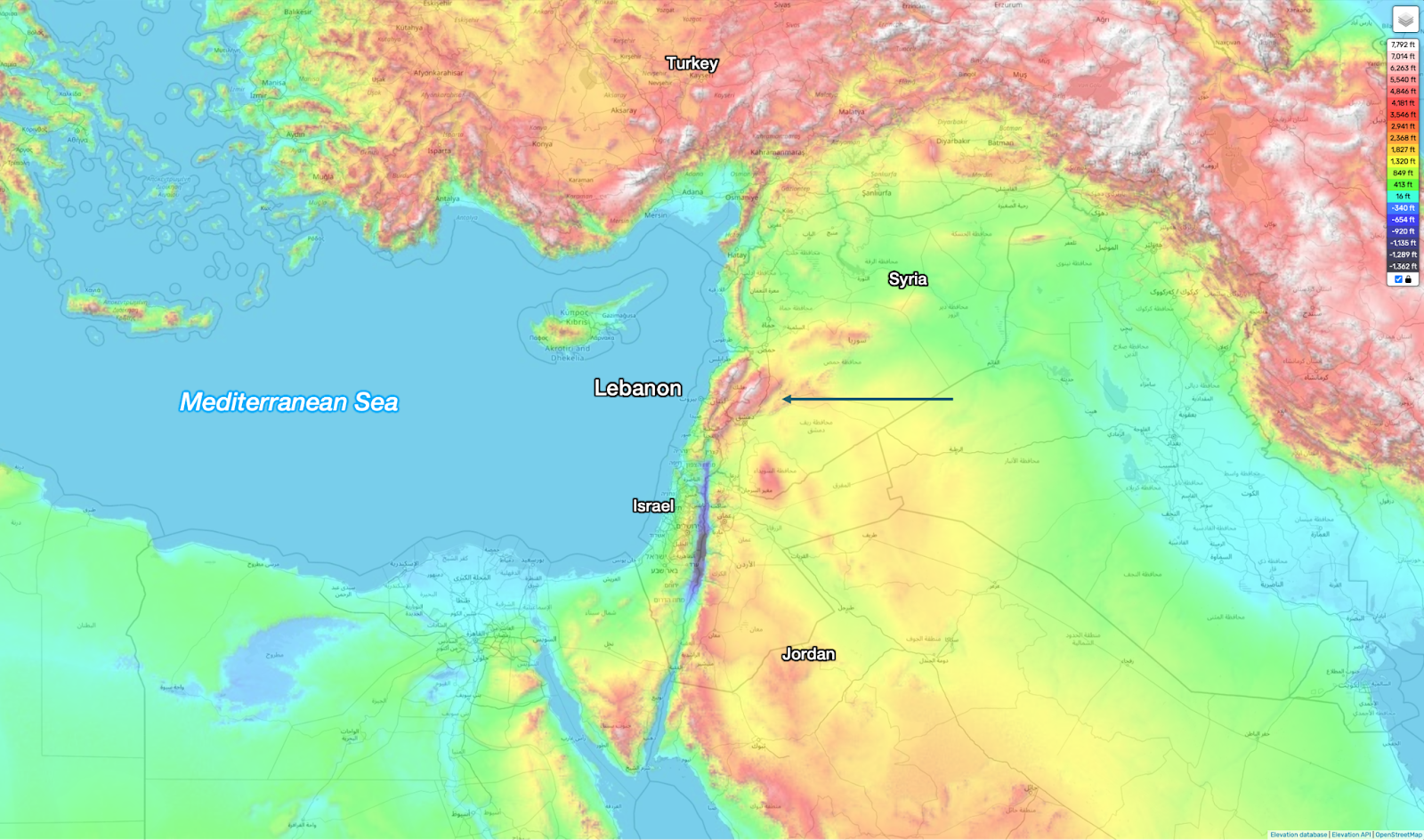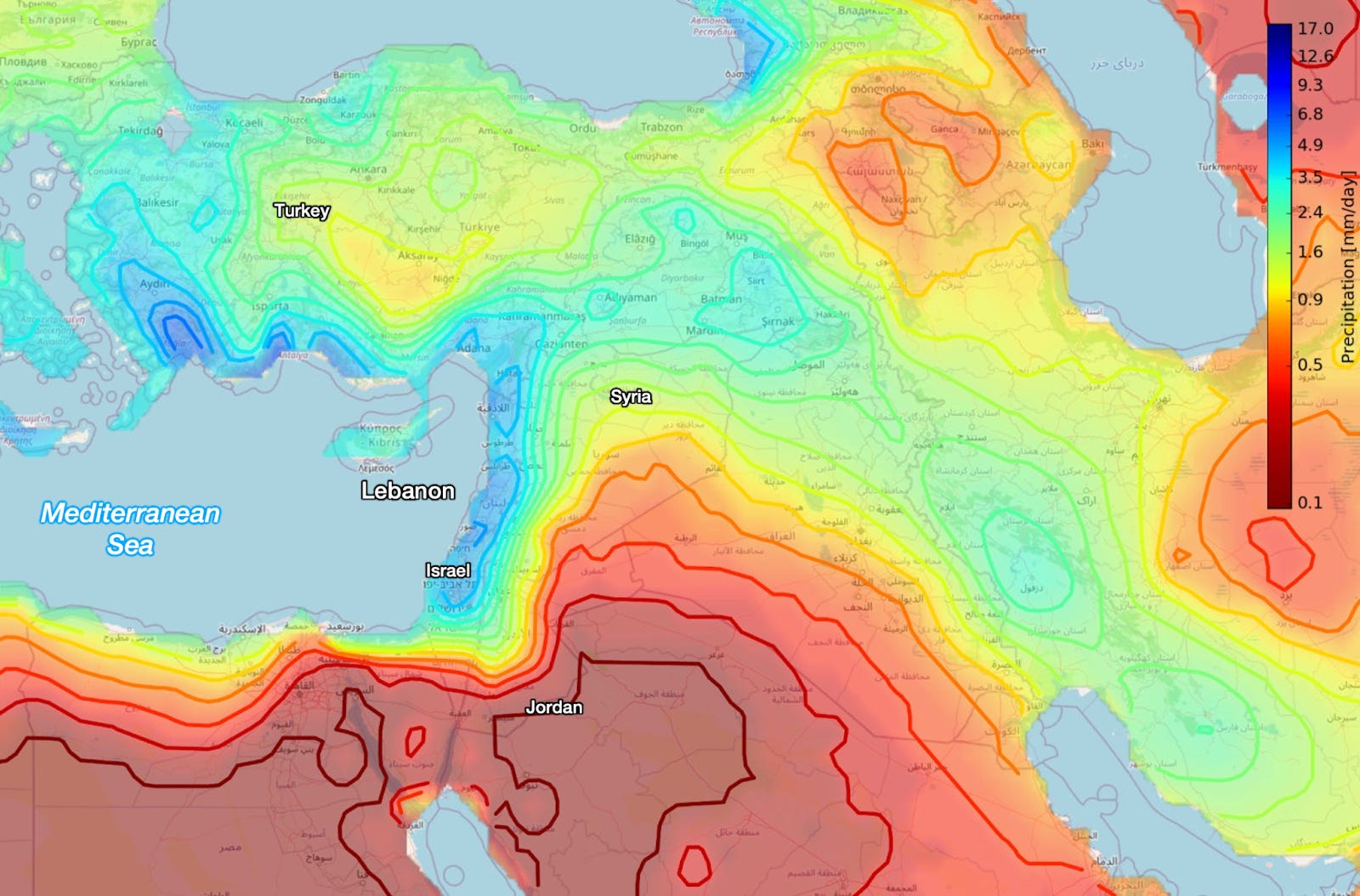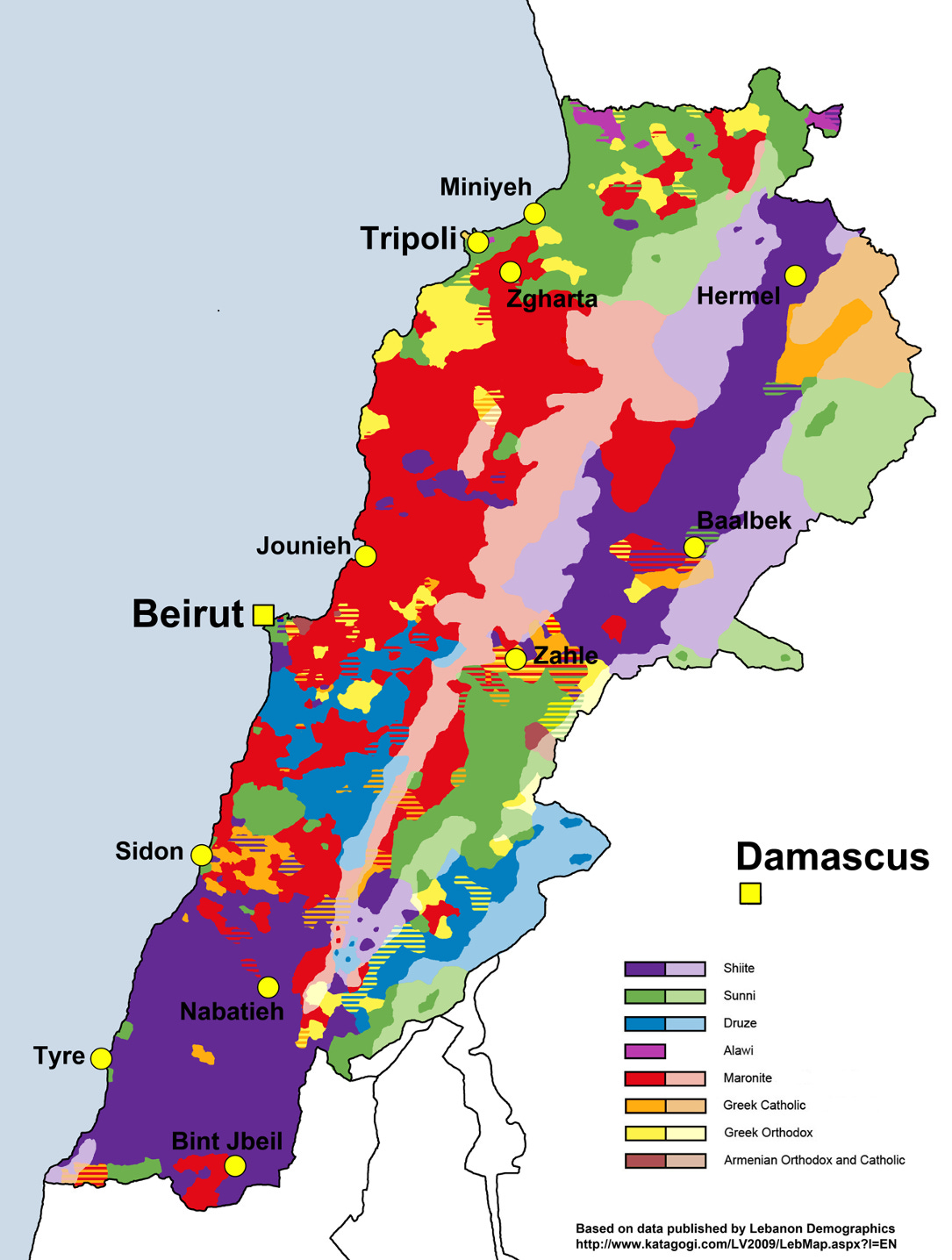Why Could Lebanon Be Rich, but Is so Chaotic?
Maven asked to move the course on Leadership Communication Mastery to November 4th. You can sign up for then if it’s better timing. I’ll write about it more in detail next week.
You need just three maps to understand Lebanon. Here are two:
Lebanon is quite unique: a thin strip of coast adjacent to two big mountain ranges. This is a map of the region, the Levant:
As I shared in Will Israel Be at War?, this area belongs to the Fertile Crescent:
Which is normally very dry because it’s in the horse latitudes, which have a similar climate across the world:
But Lebanon has something special. Look at this map and find the two small white mountain ranges parallel to the sea:
This means that, although nearly everything else is desertic in the area, Lebanon is not:
The mountains are so close to the sea and so tall that they catch a ton of moisture from the Mediterranean. This is how you end up with two mountain ranges that can get snowy, sandwiched between the desert and the sea:

The word “Lebanon” comes from Mount Lebanon, which in turn comes from the Phoenician word for “white”, referring to the snowy mountaintops. Here’s a view from the mountains to the sea when they are snowy:

Here’s a view from the bottom:
All this is to show that Lebanon is unique because it’s a very thin strip of land between the sea and mountain ranges to the east—the Mount Lebanon and the Anti-Lebanon Mountains:
Most of the population is on the seaside, concentrated in the cities, while the fertile Beqaa Valley is the other big region, albeit with a smaller population:
Here’s another view so you can get a good sense of the relief

And this is from the air, on a particularly clear day:
Lebanon’s geography has completely shaped its history, and explains it to this day, which is encapsulated in Lebanon’s flag:
The stripes are likely1 the parallel mountains and valley ranges, while the tree in the middle represents the famous cedar:
This geography and these cedars determined the destiny of Lebanon.
The Phoenicians
A few thousand years ago, settlers from Mesopotamia brought agriculture to this area and mixed with the local population. Fun fact: The genetic makeup of Lebanese people today is nearly identical to what it was back then!

But whereas Mesopotamia and Egypt have plenty of land for agriculture, Lebanon doesn’t. What it does have is mountains and rain, which meant it had the biggest cedar forests in the region. Wood on one side and sea on the other meant that the locals, the Canaanites2, took to the sea. We now call them Phoenicians because that was the Greek word for them. It comes from phoinix, possibly signifying the color purple-red, and perhaps an allusion to their production of a highly prized purple dye.3

But they didn’t just trade dye.

Indeed, the mountains and their cedars pushed the Phoenicians to the sea, and the main activity there was trade, since the cost of transportation was so much lower than on land. Because they were closest to the early civilizations of Mesopotamia in location, so they were the first coastal community to receive their technology and civilization, and hence the first to take to the sea. This is why Byblos is the world's oldest sea port and one of the world's oldest continuously inhabited cities:

These seafarers then spread civilization throughout the Mediterranean:
The Phoenicians were thus the main vector of civilization and technology spread in the Mediterranean. The Greeks and Romans are simply their technological heirs, learning from them how to navigate and trade.
It’s interesting to note that the Phoenicians had the most influence on northern Africa, Mediterranean islands, and Spain’s coast. If you look at a map, you’ll see that these are places with a similar geography to Lebanon’s: Stripes of coastal greenery protected by mountains and arid land behind.
The cedar timber that grew on the mountain skirts was one of the Phoenicians’ main exports. Indeed, that’s where most Egyptian wood came from, for example. Purple dye, wine, and olive oil were others, and since they had mountains, they had sheep, bringing the wool needed for cloth. I assume they traded these for grain, since their land was not vast enough for substantial production, which would limit the population’s size.
The main difference from Israel and Palestine is that the mountains in Lebanon are taller and closer to the sea. This had a major effect: Mountain people in the Palestinian region (Judea and Samaria) remained pastoralists, while those on the plains were farmers. These were two separate groups. In Lebanon, these two were so close in proximity that they were the same people, and they took to the seas.
Unfortunately for the Levantines, they chose a bad neighborhood. Here’s a map of population today, and the 3rd and last one you need to understand Lebanon today:
The Levant is a thin strip of population, sandwiched between sea and desert, and between Mesopotamia, Anatolia, Egypt, Persia, and the Mediterranean, all of which have birthed big empires. Because it’s a thin strip, it will never be heavily populated and very strong. Today, Lebanon’s population is about 6 million. And during its history, it was always subject to the neighboring powers, as were Israel and Palestine:
You can see this regional influence by the genetic makeup I highlighted earlier: a mix of local Levantine with Mesopotamian and Greek. But also by present-day ethnic groups:
Lebanese Balkans
Of course, the majority of the population is Muslim. But it’s split between Shia and Sunni:
Then you have Maronites, a Christian Catholic sect that emerged in the 5th century AD. There’s also the Druze, an early offshoot of Islam. And Greek Catholics and Orthodox. Why did all these denominations survive? Because of geography.
There is barely any plain in Lebanon. It’s difficult to cross the country, with sea on one side and mountains on the other. It’s especially hard to move around in the mountains, and even more, those with dense woods. Invaders could control the coastal cities, but it was much harder to control the mountains—like in the Balkans. So they couldn’t impose their will and their religions, and that’s how communities like Greeks and Maronites have survived over a thousand years of Muslim occupation.
We can see this during the Crusades too, which occupied the Holy Land for about 200 years between ~1100 and 1300 AD:

The Crusaders occupied the coasts because they mostly came by ship, that’s where the vegetation is, and it’s better defended from armies from land. But of all this region, the most protected was Lebanon, so that’s where they lasted the longest.
Fun fact: The Christian community in the region has kept ties with Christians in Europe for centuries. This will become relevant later.
Lebanon’s Independence
Let’s take a step back. What are the three forces that have forged Lebanon so far?
It’s a unique spot in the region: a double mountain range hugging the sea, sheltering diverse cultures and carving out a distinct set of identities.
It’s also rich in timber for shipbuilding, and well-situated to the trading opportunities of the Mediterranean, while on land it’s at the crossroads of empires. This made it a natural trading hub.
Yet it’s wedged between regional giants that have always dominated it.
Caught between autonomy and subservience, Lebanon has long walked a tightrope—seeking independence while navigating the power struggles of its mightier neighbors.
This was obvious during the Crusades, but also a few centuries later, during Ottoman rule. The Druze leader Fakhreddine II—arguably the region's greatest leader—sought to expand Lebanon’s independence. Aligned with European powers like the Grand Duchy of Tuscany, he spearheaded reforms in the 1600s that developed the region economically and militarily. Unfortunately, he fell short of achieving full independence, and the Ottomans prevailed.
In the 1700s, the Shihab Dynasty (originally Druze but converted to Christianity) sought to balance relationships between the Ottoman Empire, France, and even Russia during its war with the Ottoman Empire. Later, in the 1800s, the Druze and Maronites had frequent clashes. The Ottomans tended to support the Druze, while the Maronites sought support from abroad.
They had kept strong ties with France since the Crusades—because the main crusading power were the Franks, and they shared a religion. France’s involvement in the region continued through the centuries, as it saw itself as the guarantor of Catholic rights in the Ottoman Empire. For example, in 1535, the King of France negotiated Capitulations with the Ottoman Sultan, receiving special privileges within the Ottoman Empire—including the protection of Catholic minorities, such as the Maronites.
So France supported the Maronites for centuries, into the 1800s. As the Ottoman Empire power dwindled, the UK was emerging as the new superpower, and the British started supporting the Druze to weaken the French.
World Wars
During WWI, the UK and France signed the secret Sykes-Picot Agreement to split Ottoman lands, and France kept Lebanon—mainly due to its historical links to the region.
One of the things France did was move the historical border between Lebanon and Syria, from the Mount Lebanon range to the Anti-Lebanon range—which doubled the country’s size, but also included a region that had been historically much more connected to Syria than to Lebanon. Notably, this added a lot of Druze and Muslim populations. The proportion of Maronites shrunk to barely 50%, while the Shia grew 4x and the Sunni 8x. The French established a political system where Maronites would be represented 6:5 vs other denominations, and the president would always be Maronite, with veto power on any legislation. This gave power to the Maronites in a country where Muslim fertility rates were higher, and where Maronites eventually became a minority.
During WWII, France lost its grip on the region, and in 1943 Lebanon finally gained its independence under the oversight of France and the UK.
Fratricidal Kaleidoscope
Once the regional powers left the Balkans—first the Austro-Hungarian and Ottoman Empires, later the USSR—the region fell into fratricide civil wars, nearly to this very day. Something similar has happened in Lebanon, on a smaller scale.
After millennia of occupation by Mesopotamians, Greeks, Romans, Arabs, Egyptians, Ottomans, and French, Lebanon became independent at last. But that doesn’t mean it was to be fully independent. Such a small country in such a tense region meant that external influences would be impossible to overcome. Today, these influences come from the newer neighboring countries of Syria and Israel, the more distant Iran, Turkey to the north, and the looming presence of the maritime superpower—the US. These countries use Lebanon as a proxy for their interests.
And since Lebanon has so many ethnic groups, every faction is aligned with a different foreign power, creating a fratricidal kaleidoscope.
But at the same time, Lebanon is still a trading region at its heart, bent towards the cosmopolitan Mediterranean.
It’s the conflict between these three forces that defines Lebanon to this day:
In between superpowers that fight for it
Mountains that balkanize it with multiple ethnicities
But also that push it to the sea to trade and be cosmopolitan
For example, Lebanon became an international destination after WWII. But as the Cold War erupted, the East and West Blocs started recruiting allies. Muslim countries like Egypt and Syria, governed by socialists, initially aligned with the USSR. At the same time, a pan-Arabic sentiment was emerging in the region, which meant the Sunni and Shia communities (and the Druze) in Lebanon gravitated towards their Arab neighbors and the USSR. Meanwhile, the internationalist Christians, which included the Maronites, Greek Orthodox, and Greek Catholics among others, gravitated towards the US and capitalism. In 1958, this led to a conflict between Maronites and Muslims, which ended with a US intervention that lasted three months.
Here’s another example: In 1948, when Arab Muslims lost against Israel, 110,000 Palestinians left for southern Lebanon. Some more came in 1967 when Israel won the Six-Day War, and more in 1970 when Palestinians were expelled from Jordan, and the Palestinian leadership established its base in southern Lebanon. Palestinians started attacking Israel from Lebanon, and Israel retaliated. This further split the Lebanese: The Muslims supported the Palestinians, while the Maronites supported the Israelis.

Eventually, these tensions led to an invasion of Israel and international intervention:

You can see that a big chunk of Lebanon was occupied by Syria (dark green). Remember that the Anti-Lebanon mountains and Beqaa Valley (between Lebanon and Anti-Lebanon) had been part of Syria before the French allocated it to Lebanon, so strong ties remained.
Also, although Syria is a majority-Sunni country, its leadership is from yet another ethnicity, the coastal Alawites.

The Alawites persist for the same reason as the Maronites and the Druze: Coastal mountains. But in Syria, they have the power.
Syria didn’t want any threatening group to gain the upper hand in Lebanon. That included the Maronite Christians, of course, but also Israel, and also the Sunnis—the majority group in Syria. Since the Palestinians were the strongest Sunni armed force in the region, Syria wanted to counter them. So they also intervened and occupied part of the country—until 2005—and supported the emergence of a Shia counterforce: Hezbollah.
Takeaways
Lebanon is chaotic because it’s a unique mountainous region surrounded by sea, desert, and stronger powers:
The sea and mountains made it somewhat fertile, so it developed a population
The sea and its access to foreign powers made it a natural trading hub
The mountains allowed many different ethnic groups to survive for centuries
The surrounding superpowers have a vested interest in influencing or controlling the country, so they try to do that either directly or by supporting their favorite group
Since every superpower has different goals and follows different politics and religions, they support different groups in Lebanon, who end up in conflict
What does it mean for Lebanon’s future?
What are the country’s priorities?
We’ll see in an upcoming article.
There are a couple of interpretations of the flag. One is that the central white stripe of the flag corresponds to the Mount Lebanon mountains, and the two red stripes are the coast and the internal Beqaa Valley. Another interpretation is that the red stripes correspond to the mountain ranges, and the white stripe is the Beqaa Valley. Yet another is that the red represents the suffering of the Lebanese to create the country. A final one is that the red and white stripes were inherited from a Druze heraldic flag.
A semitic population, very similar to Israelis at the time.
The local Phoenicians were named Phoinikes for Tyrian Purple. The Greek historian Herodotus tells us that the Greeks first bestowed the name Phoenicians or "Purple people" because their skin was always stained by the dye, extracted from mollusc butts. It was once 15x more valuable than gold. They say that one pound of purple cloth is worth the equivalent of $60,000 today!





















I had the chance to visit it for a wedding 15 years ago and I have to say that Lebanon is an interesting country. People were extremely welcoming, and they have a quite a bustling social life, especially in Beirut.
I will add some comments that I think might be relevant to the overall context. The Christian population used to be a majority in the country in the 60s (up to 55%), and it has shifted over the years, mainly due to the Lebanese diaspora (4 million Lebanese people live currently abroad, almost as much as in Lebanon). Lebanese diaspora explains a lot of the internal dynamics of the country.
The other comment is around the Druze population. Their religion, more than an offshoot of Islam should be consider a syncretic religion that takes a bit of several Abrahamic religions, including Christianity, Islam, and Zoroastrianism, but also quite a lot of chunks of Greek philosophy. One of the most interesting things that I saw during the weeks I spent in Lebanon was how Muslims and Christians were equally marginalizing the Druze population. I never got anything more than "they are not to be trusted" from anyone in Lebanon, which didn't sound great (of course, this was just my personal experience with the people I dealt with).
Waiting for more on this and see what you will cover. There is a lot to talk about this country!
Great article about an interesting geological area. The Levant has a fascinating history.